Abstract
One thousand and one men, aged 35-65 years, were identified from the age-sex register of one group general practice. Over four years 900 men were visited at home and asked questions about symptoms potentially related to sleep apnoea and snoring. Height, weight, neck circumference, resting arterial oxygen saturation (SaO2), and spirometric values were also determined. All night oximetry was then performed at home and the tracing analysed for the number of dips in SaO2 of more than 4%. Subjects with more than five dips of 4% SaO2 or more per hour were invited for sleep laboratory polysomnography. Seventeen per cent of the men admitted to snoring "often." Multiple linear regression techniques identified and ranked neck circumference (r2 = 7.2%), cigarette consumption (r2 = 3.4%), and nasal stuffiness (r2 = 2%) as the only significant independent predictors of snoring. Together these account for at least a sixfold variation in the likelihood of being an "often" snorer. Forty six subjects (5%) had greater than 4% SaO2 dip rates of over five an hour and 31 of these had full sleep studies. Three subjects had clinically obvious and severe symptomatic obstructive sleep apnoea, giving a prevalence of three per 1001 men (0.3%; 95% confidence interval 0.07-0.9%). Eighteen men had obstructive sleep apnoea only when supine and in 10 the cause of the SaO2 dipping on the original home tracing was not elucidated. The greater than 4% SaO2 dip rates correlated with the history of snoring. Multiple linear regression techniques identified and ranked neck circumference (r2 = 7.9%), alcohol consumption (r2 = 3.7%), age (r2 = 1%) and obesity (r2 = 1%) as the only significant independent predictors of the rate of overnight hypoxic dipping. This study shows that snoring in this randomly selected population correlates best with neck size, smoking, and nasal stuffiness. Obstructive sleep apnoea, defined by nocturnal hypoxaemia, correlates best with neck size and alcohol, and less so with age and general obesity.
Full text
PDF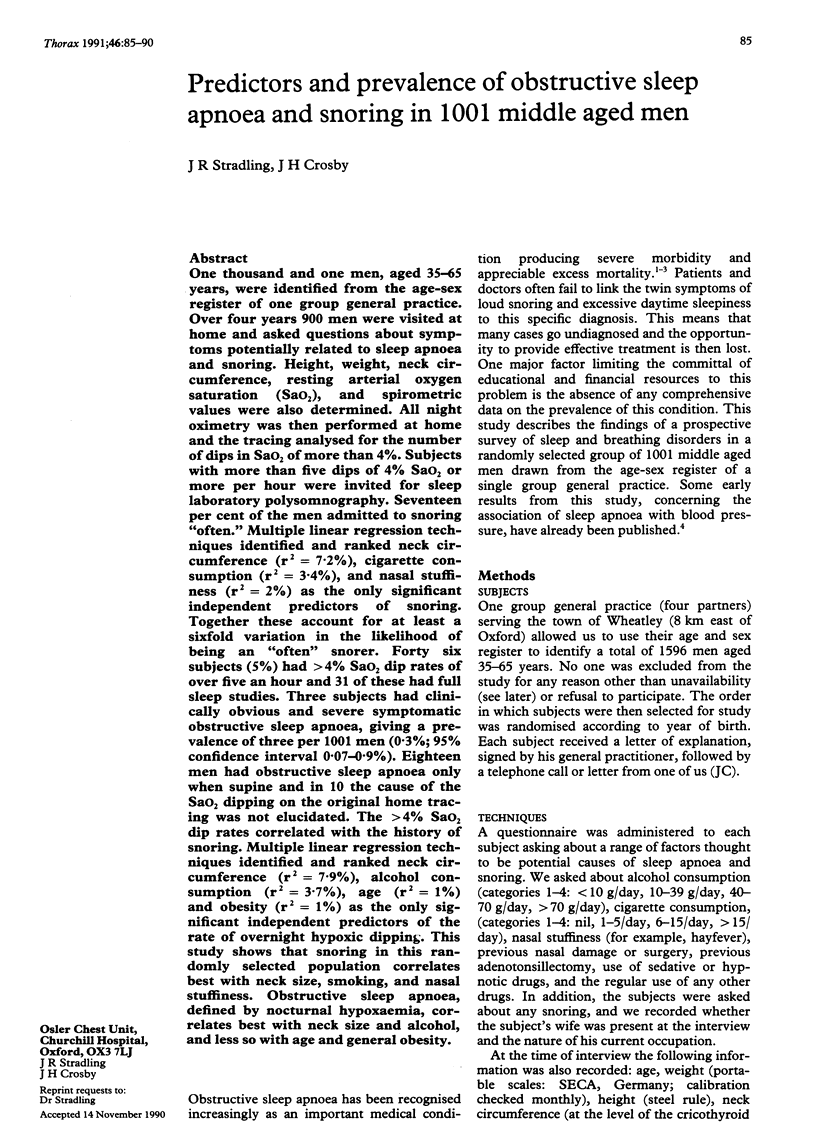
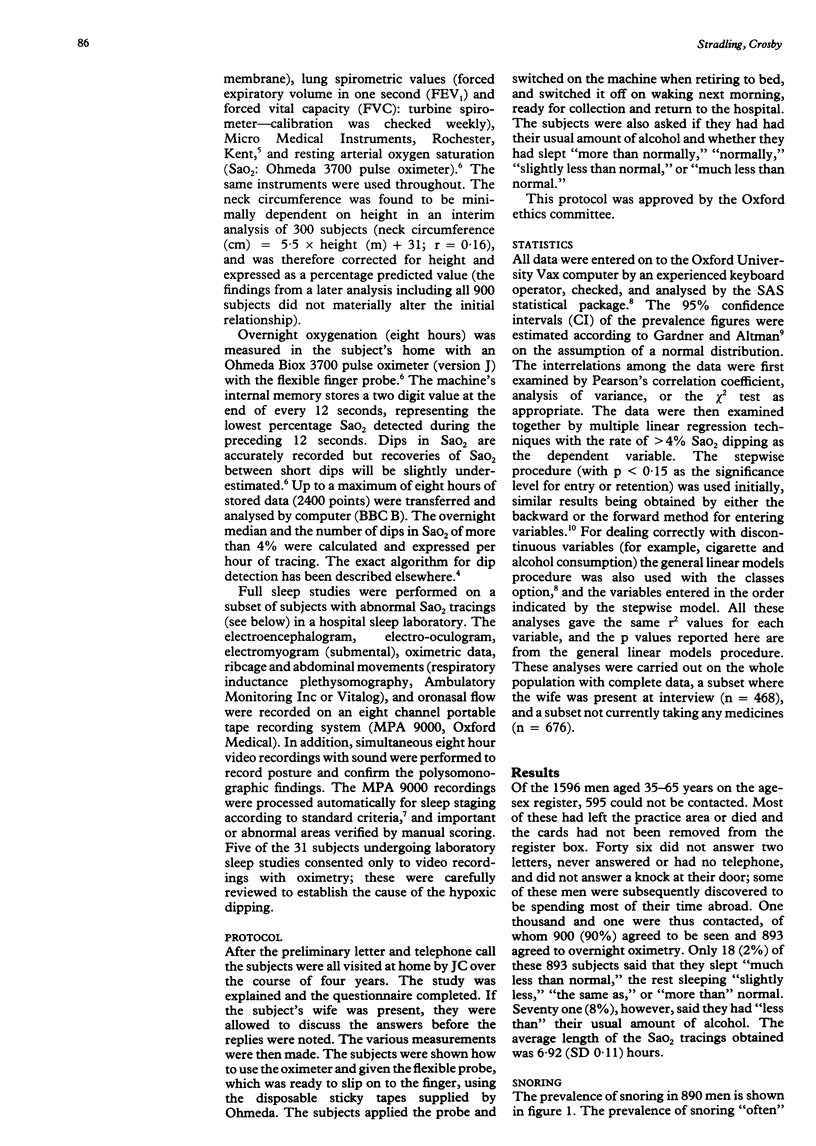
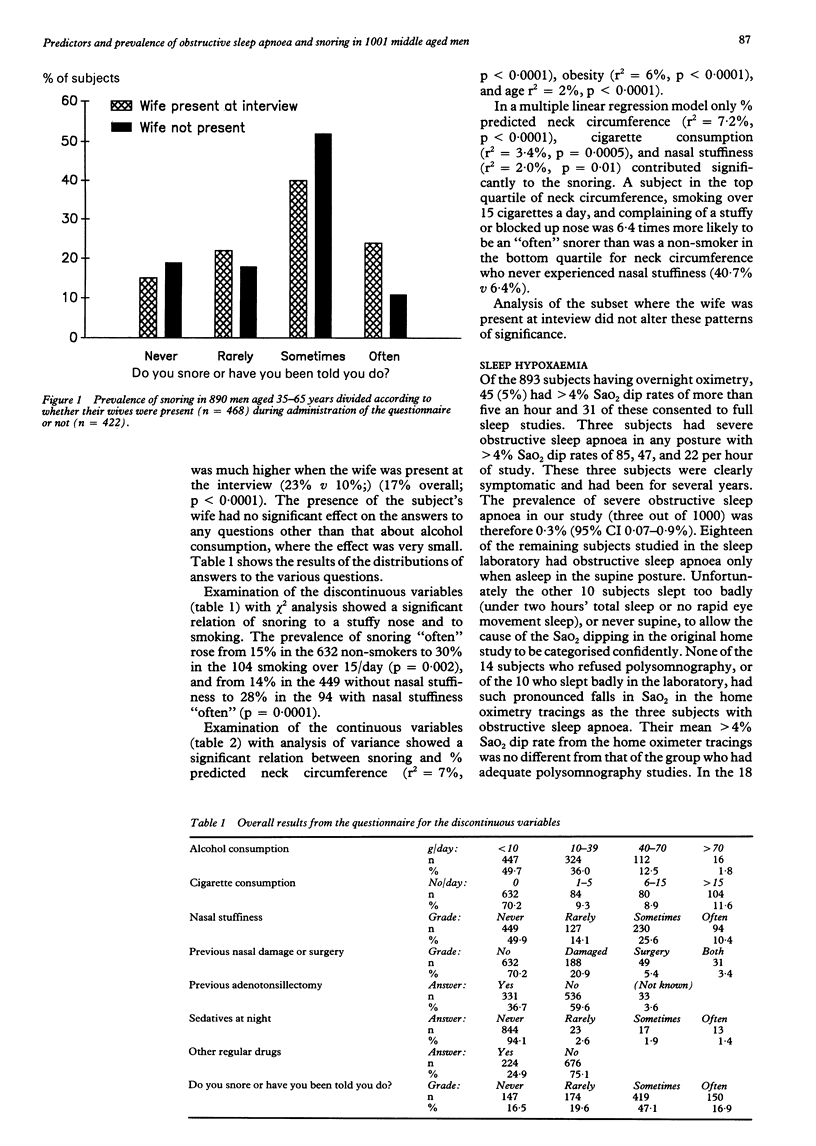
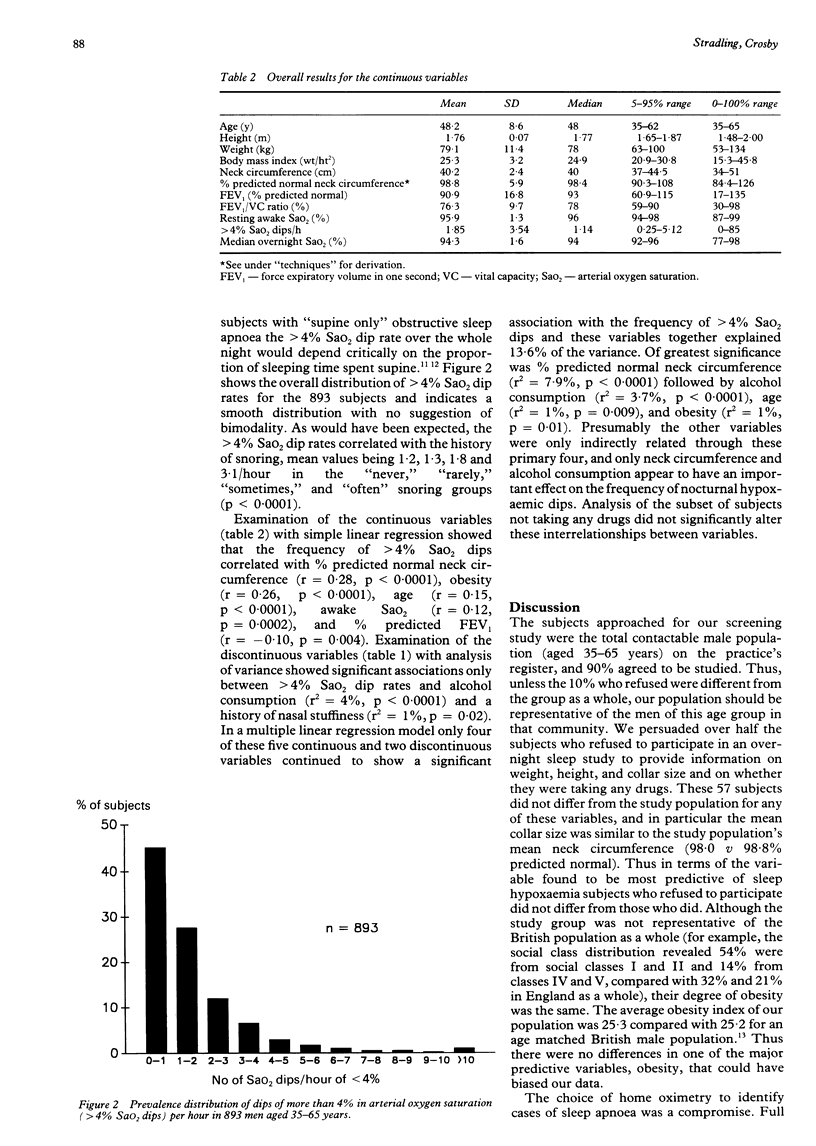
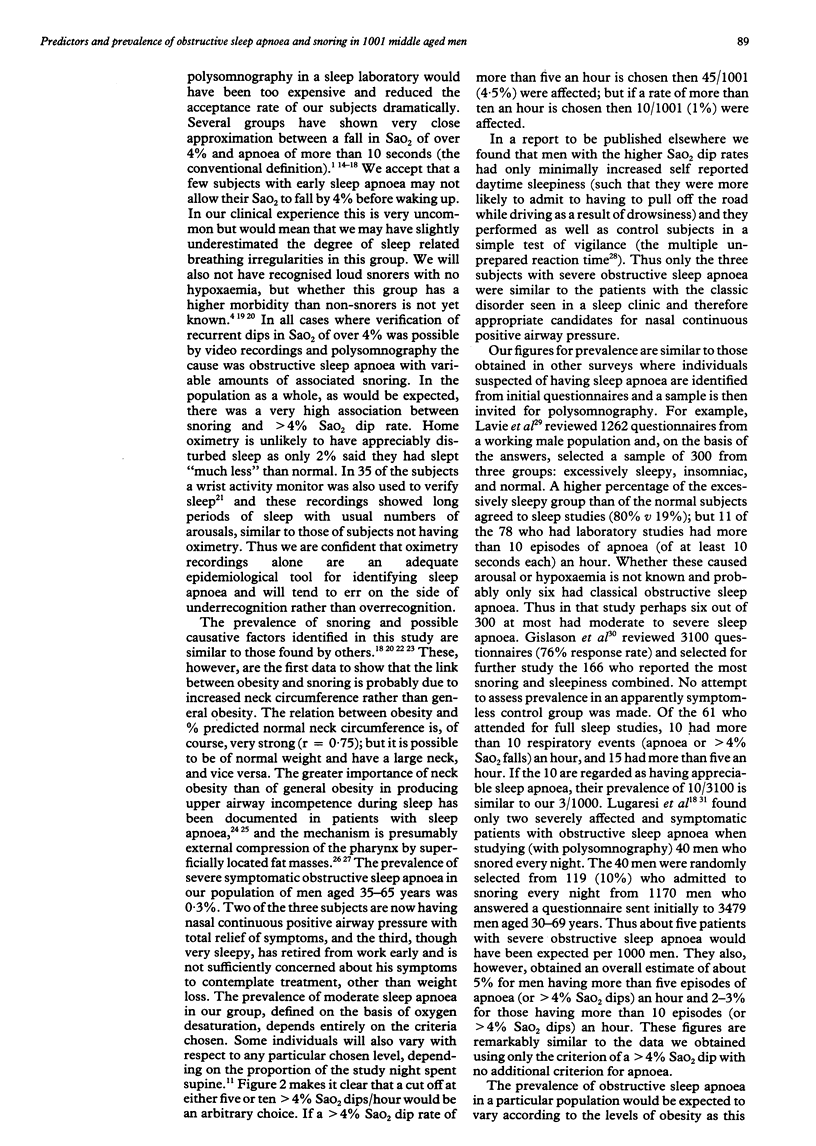
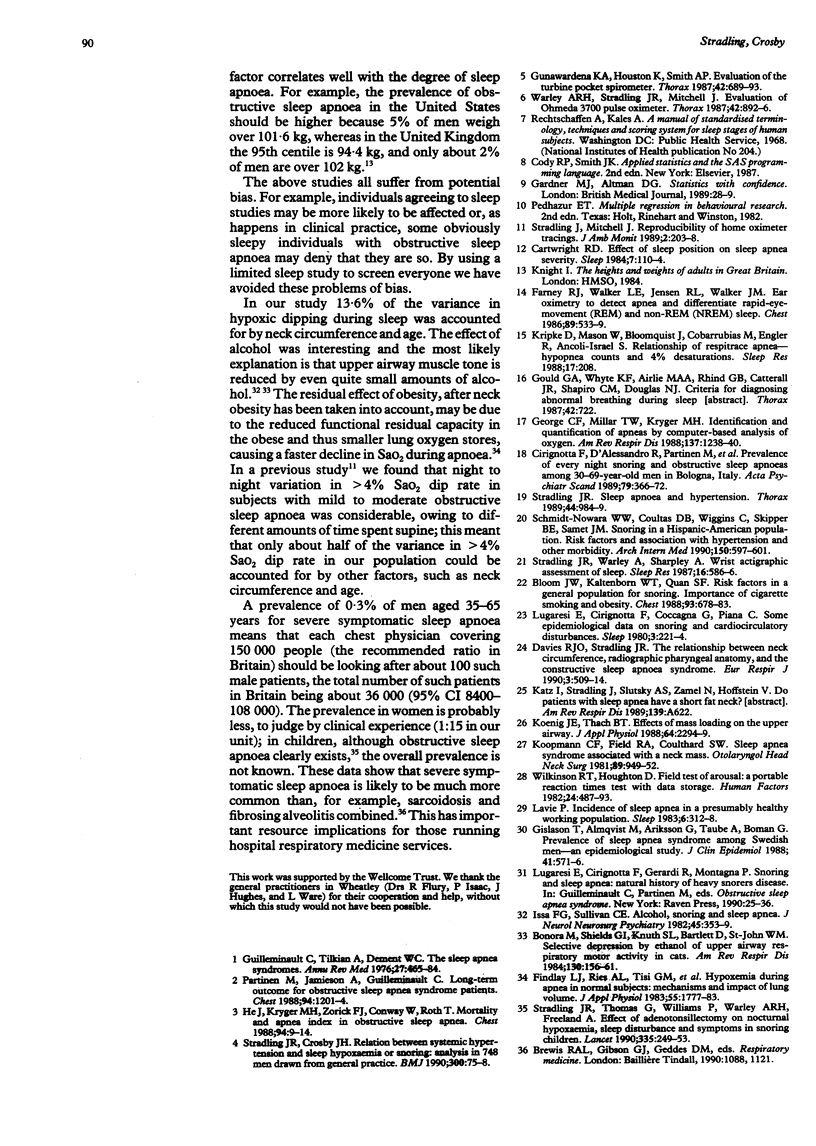
Selected References
These references are in PubMed. This may not be the complete list of references from this article.
- Bloom J. W., Kaltenborn W. T., Quan S. F. Risk factors in a general population for snoring. Importance of cigarette smoking and obesity. Chest. 1988 Apr;93(4):678–683. doi: 10.1378/chest.93.4.678. [DOI] [PubMed] [Google Scholar]
- Cartwright R. D. Effect of sleep position on sleep apnea severity. Sleep. 1984;7(2):110–114. doi: 10.1093/sleep/7.2.110. [DOI] [PubMed] [Google Scholar]
- Cirignotta F., D'Alessandro R., Partinen M., Zucconi M., Cristina E., Gerardi R., Cacciatore F. M., Lugaresi E. Prevalence of every night snoring and obstructive sleep apnoeas among 30-69-year-old men in Bologna, Italy. Acta Neurol Scand. 1989 May;79(5):366–372. doi: 10.1111/j.1600-0404.1989.tb03802.x. [DOI] [PubMed] [Google Scholar]
- Davies R. J., Stradling J. R. The relationship between neck circumference, radiographic pharyngeal anatomy, and the obstructive sleep apnoea syndrome. Eur Respir J. 1990 May;3(5):509–514. [PubMed] [Google Scholar]
- Farney R. J., Walker L. E., Jensen R. L., Walker J. M. Ear oximetry to detect apnea and differentiate rapid eye movement (REM) and non-REM (NREM) sleep. Screening for the sleep apnea syndrome. Chest. 1986 Apr;89(4):533–539. doi: 10.1378/chest.89.4.533. [DOI] [PubMed] [Google Scholar]
- Findley L. J., Ries A. L., Tisi G. M., Wagner P. D. Hypoxemia during apnea in normal subjects: mechanisms and impact of lung volume. J Appl Physiol Respir Environ Exerc Physiol. 1983 Dec;55(6):1777–1783. doi: 10.1152/jappl.1983.55.6.1777. [DOI] [PubMed] [Google Scholar]
- George C. F., Millar T. W., Kryger M. H. Identification and quantification of apneas by computer-based analysis of oxygen saturation. Am Rev Respir Dis. 1988 May;137(5):1238–1240. doi: 10.1164/ajrccm/137.5.1238. [DOI] [PubMed] [Google Scholar]
- Gislason T., Almqvist M., Eriksson G., Taube A., Boman G. Prevalence of sleep apnea syndrome among Swedish men--an epidemiological study. J Clin Epidemiol. 1988;41(6):571–576. doi: 10.1016/0895-4356(88)90061-3. [DOI] [PubMed] [Google Scholar]
- Gunawardena K. A., Houston K., Smith A. P. Evaluation of the turbine pocket spirometer. Thorax. 1987 Sep;42(9):689–693. doi: 10.1136/thx.42.9.689. [DOI] [PMC free article] [PubMed] [Google Scholar]
- He J., Kryger M. H., Zorick F. J., Conway W., Roth T. Mortality and apnea index in obstructive sleep apnea. Experience in 385 male patients. Chest. 1988 Jul;94(1):9–14. [PubMed] [Google Scholar]
- Issa F. G., Sullivan C. E. Alcohol, snoring and sleep apnea. J Neurol Neurosurg Psychiatry. 1982 Apr;45(4):353–359. doi: 10.1136/jnnp.45.4.353. [DOI] [PMC free article] [PubMed] [Google Scholar]
- Koenig J. S., Thach B. T. Effects of mass loading on the upper airway. J Appl Physiol (1985) 1988 Jun;64(6):2294–2299. doi: 10.1152/jappl.1988.64.6.2294. [DOI] [PubMed] [Google Scholar]
- Koopmann C. F., Jr, Feld R. A., Coulthard S. W. Sleep apnea syndrome associated with a neck mass. Otolaryngol Head Neck Surg. 1981 Nov-Dec;89(6):949–952. doi: 10.1177/019459988108900613. [DOI] [PubMed] [Google Scholar]
- Lugaresi E., Cirignotta F., Coccagna G., Piana C. Some epidemiological data on snoring and cardiocirculatory disturbances. Sleep. 1980;3(3-4):221–224. doi: 10.1093/sleep/3.3-4.221. [DOI] [PubMed] [Google Scholar]
- Schmidt-Nowara W. W., Coultas D. B., Wiggins C., Skipper B. E., Samet J. M. Snoring in a Hispanic-American population. Risk factors and association with hypertension and other morbidity. Arch Intern Med. 1990 Mar;150(3):597–601. doi: 10.1001/archinte.150.3.597. [DOI] [PubMed] [Google Scholar]
- Stradling J. R., Crosby J. H. Relation between systemic hypertension and sleep hypoxaemia or snoring: analysis in 748 men drawn from general practice. BMJ. 1990 Jan 13;300(6717):75–78. doi: 10.1136/bmj.300.6717.75. [DOI] [PMC free article] [PubMed] [Google Scholar]
- Stradling J. R. Sleep apnoea and systemic hypertension. Thorax. 1989 Dec;44(12):984–989. doi: 10.1136/thx.44.12.984. [DOI] [PMC free article] [PubMed] [Google Scholar]
- Stradling J. R., Thomas G., Warley A. R., Williams P., Freeland A. Effect of adenotonsillectomy on nocturnal hypoxaemia, sleep disturbance, and symptoms in snoring children. Lancet. 1990 Feb 3;335(8684):249–253. doi: 10.1016/0140-6736(90)90068-g. [DOI] [PubMed] [Google Scholar]
- Warley A. R., Mitchell J. H., Stradling J. R. Evaluation of the Ohmeda 3700 pulse oximeter. Thorax. 1987 Nov;42(11):892–896. doi: 10.1136/thx.42.11.892. [DOI] [PMC free article] [PubMed] [Google Scholar]
- Wilkinson R. T., Houghton D. Field test of arousal: a portable reaction timer with data storage. Hum Factors. 1982 Aug;24(4):487–493. doi: 10.1177/001872088202400409. [DOI] [PubMed] [Google Scholar]


